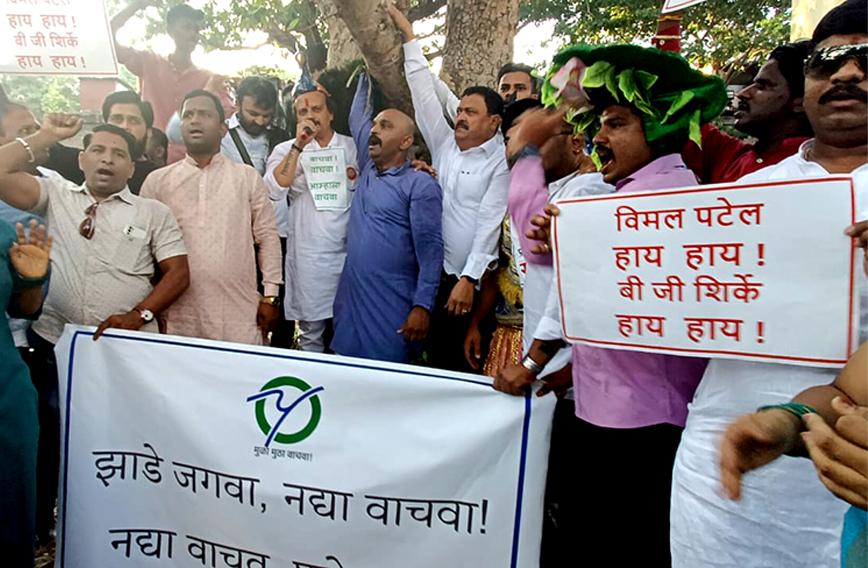
VENKATESH DUTTA
RECENTLY, over 2,000 citizens participated in a unique protest along the banks of the Mula-Mutha river in Pune by hugging trees — just like the 1973 Chipko movement to save trees in the Garhwal Himalayas.
Here, the protest was aimed at opposing the Pune Municipal Corporation (PMC)’s ambitious riverfront development project along the Mula-Mutha, which involves the removal of more than 3,000 trees from an 11-km stretch of the river. In addition to causing damage to the riverine vegetation along the river, the project, which aims to address ‘flooding’ and make the river more ‘accessible’ to people, may not achieve its intended goals.
The project has serious drawbacks. It proposes to construct embankments along the river, which will cause significant harm to the riverine ecosystem. The embankments will not aid in flood control. In reality, this will decrease the river’s water-carrying capacity, making nearby areas more susceptible to flooding.
Pune is situated at the confluence of the Mula and Mutha rivers that originate in the Sahyadri ranges. These two rivers converge to form the Mula-Mutha, which further joins the Bhima. Additionally, the Pawana and Indrayani, which are tributaries of the Bhima, flow through the northwestern outskirts of Pune. The combined length of these three rivers as they flow through the PMC area is roughly 44 km.
The riverfront development project in Pune aims to develop the 44-km stretch of all three rivers — 22 km of the Mula, 10 km of the Mutha, and 11 km of the Mula-Mutha -- at an estimated cost of `5,500 crore. The project is divided into many phases, with the first phase of work currently underway along the approximately 11-km stretch of the Mula-Mutha. In the past, uncoordinated piecemeal development of riverbanks and unthoughtful channelization of the Mutha have spoiled Pune’s rivers.
The Mula, Mutha and Mula-Mutha collectively have over 300 species of plants, including several species of grasses, herbs, shrubs, climbers, free-floating aquatic plants, and others found along the riverbanks, and in the riverbed. The river is a mosaic of habitats — the rocky bed provides unique habitation, including several small river islands, pools, small rapids, aquatic vegetation, and grassed muddy banks. The 11-km stretch of the Mula-Mutha, which is currently under development, is also a part of the Salim Ali Biodiversity Park and a proposed bird sanctuary. The riverfront development project’s impact could have far-reaching consequences on the local ecosystem and the wildlife that depends on it.
Many riverfront development projects have come up in India — the problem is that these projects lend cosmetic treatment to rivers with incomplete sewerage networks and inadequate sewage treatment. Riverfront developments have not prevented sewage from entering the river; in fact, they have escalated the city’s water and wastewater crises. Multiple sewer lines have been laid along or underneath the riverfronts. The result is that these river stretches have become ‘glorified sewer canals’. The riverfront also comes with diaphragm walls and embankments on both sides of the river. This reduces the carrying capacity of the river. So there is flooding during excessive rainfall due to the reduced width of the river channel and multiple flow obstructions. The Gomti riverfront in Lucknow is a classic example of how natural riverbanks can be ruined with concrete structures with failed sewage interceptor systems — the fact is that untreated sewage is discharged into the river, resulting in severe degradation of water quality. The oxygen in the river is almost nil at several places and fish cannot survive in such toxic water.
The phrase ‘urban river’ is being used to disconnect a river from its upstream and downstream continuum. This urban-centric approach of river management is trying to give river space an elite look, with more build-landscape and concrete river banks along the urban stretches of a river. A river is a river — while its catchments may get urbanized, its terrace may remain well-vegetated and unordered. It is definitely not an urban river. In urban areas, our municipal agencies have connected sewer lines to natural drains that empty into our rivers. The approach should focus on three aspects — first we have to clean our rivers and make them pollution-free. This requires a serious re-thinking of the city’s wastewater and solid wastes. The city’s sewerage network should be complete in all respects — existing nullahs and piped outfalls that connect to the river have to be tapped and channelled to the sewage treatment plants. Solid waste dumping around the river banks has to be stopped with a zero-tolerance policy. Second, we need to improve the aesthetics around ghats; we can develop biodiversity parks and gardens — not the concrete public realms. Third, we should integrate all heritage structures around the riverbanks and enhance the composite character of the river without destroying the natural riverbanks.
It is very difficult to maintain the large built landscape due to high operation and energy expenditure. After spending so much money, the municipal corporation or the land development agency starts looking for all possible options to generate finances. The structure can never be maintained by entry fees and rentals. Plus, the riverfront restricts the local community’s access to rivers and their public spaces.
Achieving a clean and unpolluted river in urban areas is not possible without a proper sewerage network and well-functioning sewage treatment plants. The Sabarmati riverfront development project attempted to execute interceptor sewers and sewage diversion networks, but these efforts have largely failed due to faulty design and malfunctioning sewage treatment plants. According to a report from the Central Pollution Control Board (CPCB) presented to the Lok Sabha in February this year, the Sabarmati is the second most polluted river in the country. Therefore, it is imperative to ensure that sewage treatment plants are properly installed and functional to achieve the vision of a clean and unpolluted river in urban areas such as the Sabarmati and Gomti.
The message is clear. Do not try to destroy the riverbanks and floodplain-terrace with concrete structures — first clean all the sewage generated in the city and use this reclaimed water. Maintain the circularity with caution and care — water should be used, reused and returned to nature. The natural areas around rivers should remain natural. Riparian stretches along the rivers should be protected at all cost. These areas are ecologically fragile, and restoration work should enrich their natural endowments.
Venkatesh Dutta is a Gomti River Waterkeeper and a professor of environmental sciences at Ambedkar University, Lucknow
Comments
-

MKSURESH - June 21, 2023, 11:15 p.m.
DEAR SIR, I TOTALLY AGREE WITH THIS ARTICLE.I HAVE GENERALLY OBSERVED ...IN THE NAME OF DEVELOPMENT, POLITICIANS/SOME GOVT AGENCIES..WILL REALLY SPOIL THE SARROUNDNG ENVIRONMENT.. THE FLORA AND FAUNA IS LOST. ONLY FOR AESTHETIC REASONS THESE LOOK GOOD. IN REALITY IN THE LONG RUN THERE IS MORE DEVASTATION TO PROPERTIES AND HUMAN LIVES BY WAY OF CAUSING FLOODS. IN MOST CASES ,THE GOVT DOES NOT INVOLVE LOCALS TO FIND OUT HOW BEST ANY PROBLEM CAN BE SOLVED. I AM TOTALLY WITH YOU REGARDING THIS PROJECT. MKSURESH ,SRCTZN, BLORE, 21...6..2023.
-

Dr. Narasimha Reddy Donthi - June 21, 2023, 10:34 a.m.
Yes. Riverfront projects in India have become capital and concrete intensive investments, which try to reshape the rivers. these are not restoration projects. these projects do not include public consultations either. These are driven by consultants, and architects, who do not envision the implications and various linkages. River Musi in Hyderabad is also under severe strain of encroachment because the so-called river front project. Recent floods have not instilled sense and rational in GHMC and other urban bodies.




